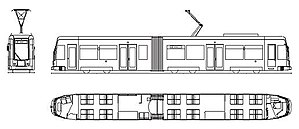Articulated railcar NGT6DE
The low - floor articulated railcar NGT6DE is a Flexity Classic tramway car from Bombardier . One after the other, the Dessauer Verkehrsbetriebe ordered 10 cars, HAVAG Hall 30 and later another 12 cars and finally the Plauen tram 9 cars (with the option of one more). The vehicles are designed for around 120 passengers, 50 of them on seats (Dessau 52). They are around 21 meters long and 2.3 meters wide. They have a low-floor share of 70% and reach a top speed of 70 km / h.
construction
The vehicles are manufactured in the Bombardier plant in Bautzen. The Dessau wagons received the electrical equipment from Krefeld, Halle and Plauen received this from Bombardier Mannheim. The vehicle heads and rear parts of the Dessau series were supplied by FTD Fahrzeugtechnik Dessau .
The Halle vehicles received doors on both sides so that two coupled cars can be used in bidirectional operation. That is why the bumpers on the front sides are missing, which in Dessau looks like a “thick lip”. However, there is only a door on one side of the cab-free end. The Albert couplings only needed for towing purposes in Dessau have been replaced by Scharfenberg couplings in Halle . Dessau and Plauen received pure furniture trolleys.
The second Hallesche series and the Plauener were given a new front design with LED daytime running lights.
Delivery and operation


The Dessau vehicles
The first car reached the Dessau tram depot on December 21, 2001 . Another vehicle was added every two weeks, so that in July 2002, just in time for the West network expansion, all vehicles were in operation. The numbering scheme started with 301 in mid-January 2002. The reason for this numbering is that the buses are numbered 100 to 199, the coaches and special buses 200-299. Thus, the trams were assigned the number range 301 to 310. As with every new vehicle, there were some technical problems at the beginning. Today, a ninety percent usage rate can be expected. The main inspections (HU) began in April 2007. The first vehicle was the railcar 303, which was used again in October. The rear windscreen wiper was omitted during the main inspection. The approach technology has also been refined.
The Halle vehicles
The first car reached Halle on April 6, 2004. The cars were delivered every four weeks, so that in December 2005 the thirtieth MGT-K was delivered. In Halle, the cars were given the numbers 661 to 690, that is, after the MGT6D railcars . The NGT6DE carry the abbreviation in Hall MGT-K ( M eterspur- G élénk t riebwagen- K URZ), they are usually used as coupled to the cab loose ends of double units. This is the principle of the one -and-a-half-direction car . At the end of 2010, HAVAG ordered another twelve vehicles (MGTK-2), which were delivered between May and August 2013. The new vehicles with the numbers 691 to 702 received a new front section and a new interior. HAVAG has not yet redeemed an option for four more MGTK-2s.
The Plauen vehicles
In May 2011, the Plauen tram tendered two low-floor cars with an option for a further eight. In January 2012, Bombardier was named as the winner of the tender. In November 2012, the first part of the option was redeemed for a further four shares. On August 20, 2013 Plauen received the first car with the number 302, car 301 followed on August 22. This and the next four cars (303 to 306) were commissioned by 2014. At the end of 2015, the option for a further three vehicles was exercised.

